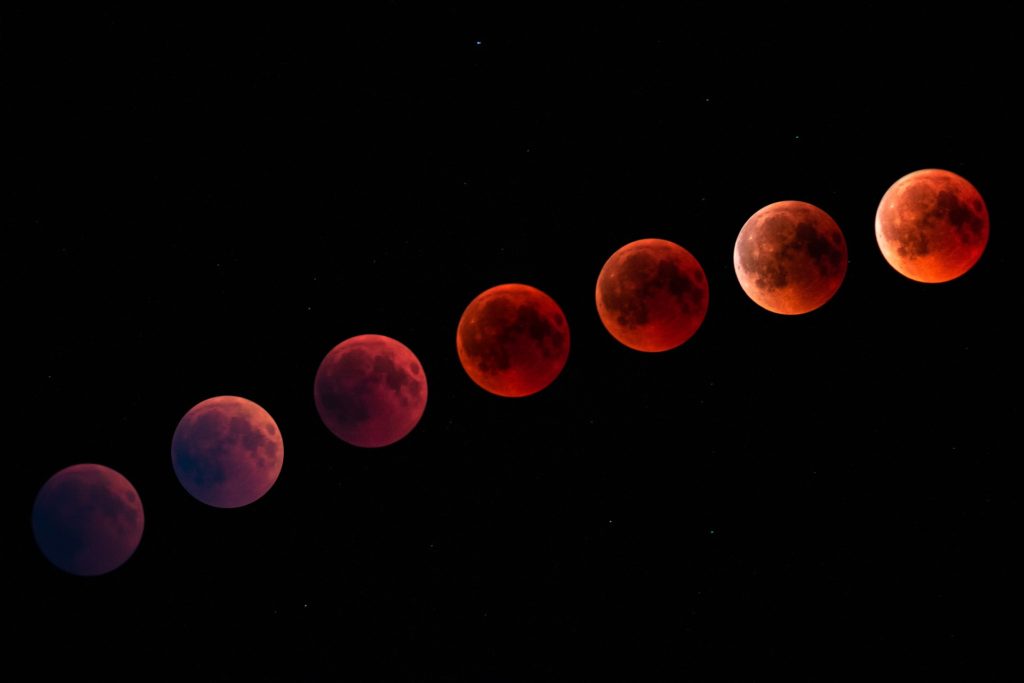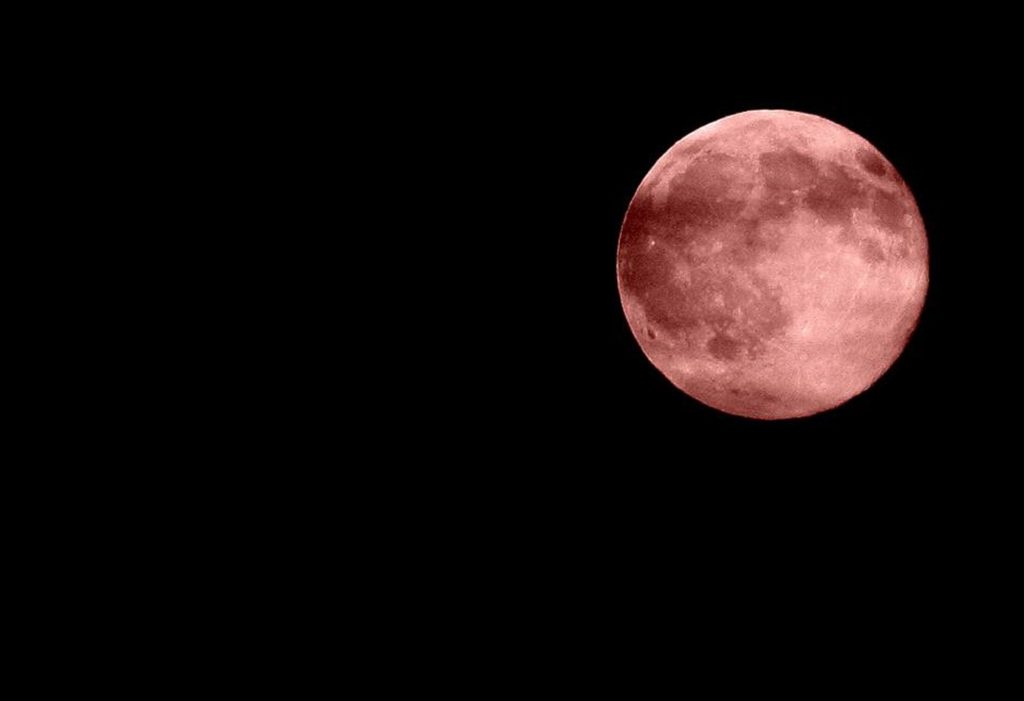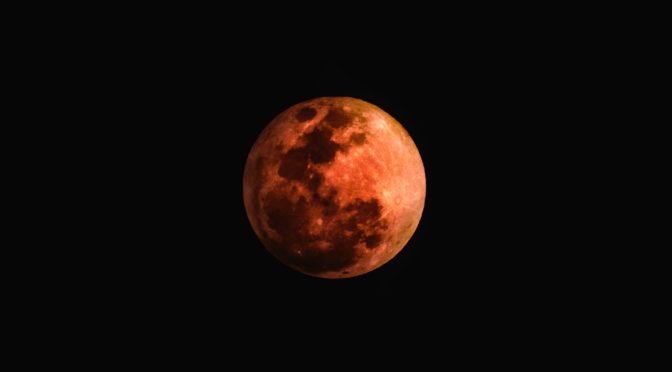Red moon meaning: A red moon is not a normal occurrence. It has nothing to do with the fact that it is a full moon. The red tinge sometimes seen around a full moon is simply the result of the earth’s atmosphere.
This particular effect can occur around any time when sunlight passes through a lot of atmospheres to reach your eyes, such as at sunrise or sunset, and also sometimes during eclipses when the light has to pass through more atmosphere than usual just to reach you.
Light from the sun is made up of many different colors (or wavelengths) of visible light. Each color of light has its own wavelength, which determines what color we see it as.
When sunlight passes through the atmosphere, some of it scatters off molecules in the air, particularly nitrogen and oxygen molecules. Blue light scatters much more than red light; this is why the sky appears blue. This effect is called Rayleigh scattering.
If you are looking at a full moon low on the horizon at sunset or sunrise, then the sunlight reaching your eye has to pass through more air than if you were seeing it directly overhead. More air means more Rayleigh scattering, which means that more blue light gets scattered away from your direct line of sight toward the moon, leaving behind more red and
A red moon is a condition in which the moon appears to be of a reddish color. It is caused by a lunar eclipse. The Earth passes between the sun and the moon, only allowing certain wavelengths of light to reflect off the moon. This causes the phenomenon known as a “red moon.”

Is There an Astrological Meaning
A red moon (or a blue moon) has no astrological significance. The term “red moon” is used to describe the appearance of the Moon during a total lunar eclipse. During this time, light from the Sun passes through the Earth’s atmosphere and is bent toward the red end of the spectrum. This same refraction effect causes sunsets and sunrises to appear reddish.
The term “blue moon” was coined in 1946 by amateur astronomer James Hugh Pruett, who mistakenly interpreted an article in Sky and Telescope magazine as saying that a blue moon is the second full moon in a month (instead of its correct definition: the third full moon in a season when there are four full moons). A blue moon happens only about every 2 1/2 years, so it’s a fairly rare event. However, this rarity has no astrological significance.
The astrological meaning of a red moon is the same as that of any other colored moon. The only difference is that a red moon is more likely to be noticed.
A red moon happens when there is a full moon and the Earth, sun, and moon are nearly in a straight line. As seen from Earth, the sun has just set, and so it shines on the opposite side of the moon (or nearly so) from us. This gives the moon a reddish tint.
The general meaning of a full moon is that something is coming to completion or fruition. It’s not necessarily good or bad; it doesn’t mean there will be a lunar eclipse, much less that someone will bleed or die. It just means that something is happening now that hasn’t happened before and won’t happen again soon. Something significant might be ending or reaching its climax, or something dramatic might be about to begin.
Interpretation of a Red Moon
A red moon is one of the most beautiful and unsettling sights in nature. It occurs when sunlight hits the earth’s atmosphere in just the right way to reflect only red light.
For thousands of years, red moons have been a source of terror and wonder. They were seen as portents of doom, signaling war or famine.
The question is: does a red moon affect people differently than a regular moon?
I believe it does. During a recent study, I asked 200 people whether they felt different during a red moon. They all said yes, and some reported intense feelings of sadness or anger during this time.
I believe that during a regular moon, we are able to release our emotions more effectively than when there is a red moon. When the colors are not distorted by the refraction of light through the atmosphere, we feel more at peace with ourselves and others.
A red moon should be avoided whenever possible.
It is a historical fact that the moon is not always white. Sometimes it is red.

Ancient Meaning of a Blood Moon
The Hebrew word “tetragrammaton” (YHWH) means “the red one.” The ancient Greeks called red the color of Mars, their god of war. Red is also the color associated with Tammuz, Osiris, and Baal. In each case, these gods are symbolized by an upright pillar or obelisk. In each case, these gods are symbolized by an upright pillar or obelisk.
Finally, we have Nimrod, who was also known as Baal and Tammuz. Nimrod was the builder of the Tower of Babel and his followers were scattered when God confused their languages. We know this tower as the Washington Monument in D.C. It is interesting that this monument points directly to Sirius, the star system from which, according to some theorists, our ancestors came from. It is also interesting that Sirius rises in June/July just like Jupiter
A blood moon is a total lunar eclipse when the Earth blocks the sun’s light from striking the moon. The sunlight changes its path as it passes through our atmosphere and casts the moon in a reddish hue.
The term “blood moon” has been used for centuries as a way to describe total lunar eclipses. It gained popularity in recent years because of a prophecy that four consecutive blood moons would herald major events for Israel — which inspired several books and at least one documentary.
Conclusion
Blood red moons are a relatively rare celestial phenomenon, which happens when the earth comes between the sun and the moon. The earth’s atmosphere filters out the blue light from sunlight, scattering it in all directions – which is why the sky appears blue.
But if an object passes directly in front of the sun and into our line of sight, then no blue light will be scattered, leaving only red light to illuminate the object. That’s why a lunar eclipse looks red: during an eclipse, the moon passes into the earth’s shadow.
The moon appears red when it passes through Earth’s shadow because Earth’s atmosphere scatters blue light. Because Earth has an atmosphere and Mars does not, Mars’ moons can look blue when they pass through Martian shadow (this is called Rayleigh Scattering).
The result is that the moon seems to turn blood red during an eclipse. It won’t be quite as dramatic as this picture, though: our sky is never as black as space, so you’ll still be able to see some stars and planets while you’re watching.
While this phenomenon might seem rare, there have actually been five total lunar eclipses since 2011 alone.
Disclosure: I may receive affiliate compensation for some of the links above at no cost to you if you decide to purchase anything. This site is not intending to provide health or financial advice. This is for entertainment only. Please consult a professional as you see fit.
